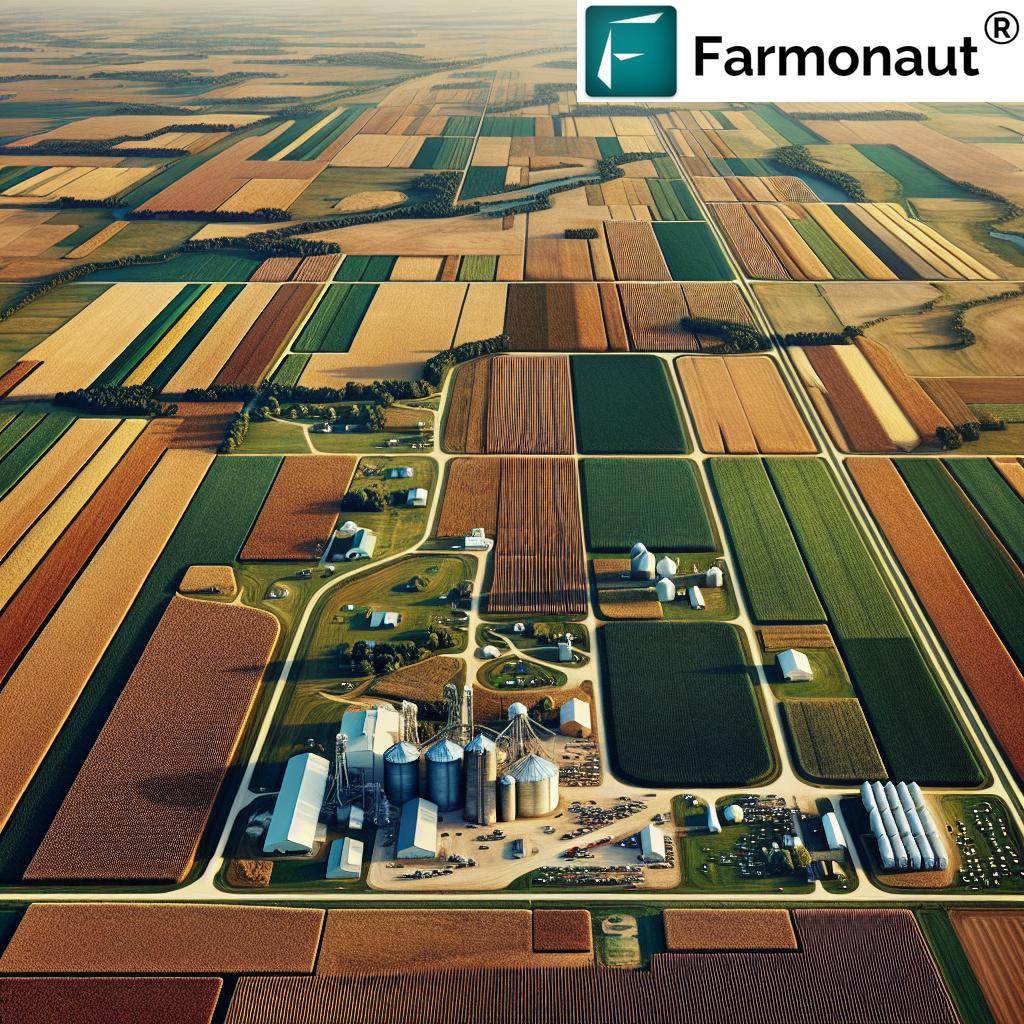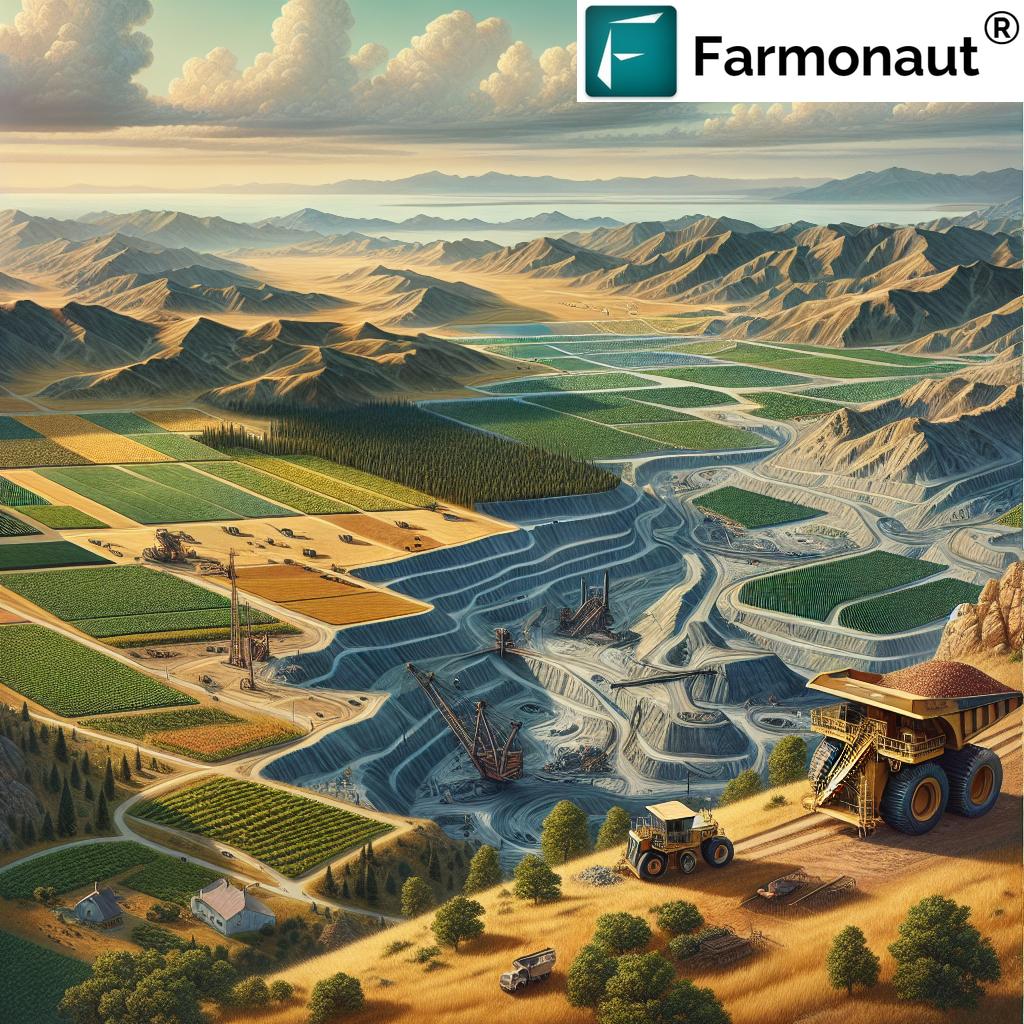Substantial Agriculture: 7 State & USDA Subsidy Tips 2026
“Federal and state subsidies supported over $40 billion in sustainable agriculture initiatives across 7 states in 2025.”
“In 2025, USDA climate-smart subsidy programs improved food security for more than 10 million rural households.”
- Summary: The Role of Agricultural Subsidies in Strengthening State Agriculture and Rural Development in 2025
- What is Substantial Agriculture? Understanding the Backbone of 2025 Agriculture
- Why Agricultural Subsidies Are Vital for Rural Economies in 2026
- How Government Subsidies for Agriculture Work: Policy Frameworks, Mechanisms & Impact
- 7 Tips: State Agriculture Support & USDA Climate-Smart Subsidies for 2026
- State & USDA Subsidy Comparison Table (2025 Data)
- Climate-Smart Subsidies: Supporting Food Security & Rural Development
- How Farmonaut Supports Substantial Agriculture & Sustainable Subsidy Programs
- FAQ: Agricultural Subsidies and Sustainable Farming in 2026
Summary: The Role of Agricultural Subsidies in Strengthening State Agriculture and Rural Development in 2025
Agriculture remains the backbone of rural economies worldwide, sustaining livelihoods, ensuring food security, and contributing significantly to national GDP. In 2025 and beyond, the importance of agricultural subsidies is paramount as governments strive to stabilize agricultural markets, promote sustainable farming practices, and support rural development.
Government agriculture subsidy policies have evolved to tackle multifaceted challenges: mitigating farm risks, encouraging climate-smart and sustainable practices, and fostering vibrant rural communities. These subsidies are not only financial aids but are strategic instruments bolstering food systems, stabilizing markets, and driving innovation in substantial agriculture.
On the state level, subsidy frameworks are tailored to local needs, encompassing direct payments, crop insurance, technology incentives, climate-smart initiatives, rural infrastructure investments, and sustainability benchmarks. At the national level, USDA agricultural subsidies exemplify the fusion of food security, environmental stewardship, and rural prosperity.
As global challenges intensify in 2026, aligning govt subsidy for agriculture with environmental and rural development goals remains crucial for resilient, profitable, and sustainable food systems.
What is Substantial Agriculture? Understanding the Backbone of 2025 Agriculture
Substantial agriculture refers to large-scale farming operations that produce significant quantities of crops and livestock, frequently integrating advanced technologies and mechanization into their systems. These farms play a crucial role in meeting national and global food demand, driving exports, and supporting rural livelihoods.
- Scale & Output: Substantial agriculture involves sizable tracts of land, often with diversified cropping patterns or integrated livestock production systems.
- Technology Adoption: Use of modern equipment, precision farming, smart irrigation, and satellite-based monitoring is prevalent.
- Supply Chain Influence: These farms stabilize food supply chains, buffer market fluctuations, and contribute to food security at national and international levels.
Despite their strengths, large operations face substantial risks like:
- Climate variability (droughts, storms, extreme weather events)
- Fluctuating commodity prices in global and regional markets
- Crop pest outbreaks and disease epidemics
- Rising input costs (seeds, fertilizers, fuel, machinery)
These risks threaten the ability to maintain stable yields, invest in innovation, and ensure profitability for farmers.
Why Large-Scale Farms Need Agricultural Subsidies
With the backbone of food systems at stake, supporting substantial farms through agricultural subsidy programs is critical. These financial mechanisms act as shock absorbers, enabling farms to:
- Invest in innovative and modern agricultural equipment
- Adopt data-driven and sustainable farming practices
- Mitigate risks imposed by climate or market volatility
- Maintain production levels in the face of adversity
Properly directed subsidies promote stability in agricultural markets, ensure reliable food production, and support broader economic development in rural areas.
Why Agricultural Subsidies Are Vital for Rural Economies in 2026
Agriculture rural regions, especially in the United States, depend on vibrant farm activities for community survival, economic stability, and food provision. As we progress into 2026, the role of subsidies becomes even more crucial because:
- Stabilizing Farm Incomes: Subsidies help stabilize incomes during crop failures, low commodity prices, or disasters, preventing rural poverty.
- Reducing Outmigration: Financial support makes agriculture viable, discouraging rural residents from migrating to urban centers in search of work.
- Boosting Local Infrastructure: Subsidy programs often support development of irrigation networks, rural roads, grain storage, and local markets.
- Enabling Smallholders: Govt subsidy for agriculture can be targeted to small family operations, supporting resilience and food diversity.
- Encouraging Sustainability: Climate-smart subsidies incentivize soil health preservation, water conservation, and ecosystem protection.
The economic multiplier effect of state agriculture support cannot be understated: for every dollar invested, multiple dollars circulate in local economies, creating jobs, fueling agri-business, and strengthening food systems.
How Government Subsidies for Agriculture Work: Policy Frameworks, Mechanisms & Impact
At the heart of successful agricultural subsidy strategies are policy frameworks designed and administered by state agriculture departments and federal agencies like USDA. By 2026, these frameworks increasingly emphasize environmentally responsible subsidies and climate-smart initiatives.
Key Types of Agricultural Subsidy Mechanisms
- Direct Payments: Per-acre or per-unit payments based on crop type, acreage, or historic production.
- Input Subsidies: Discounts or reimbursements for seeds, fertilizers, machinery, and other input costs.
- Crop Insurance: Premium support and guaranteed payouts during crop failures due to weather, pests, or disease.
- Price Supports: Programs ensuring minimum prices for commodity crops like corn, wheat, rice, soybeans.
- Climate & Conservation Incentives: Payments tied to adoption of methods that improve soil health, sequester carbon, conserve water, or reduce fertilizer use.
- Disaster Assistance: Rapid relief for farmers facing unforeseen challenges like drought, flooding, or disease outbreaks.
- Rural Development Grants: Funds directed towards building infrastructure, cooperative storage, farm-to-market logistics, and broadband for rural communities.
State governments play a pivotal role in designing and tailoring policy to local agroclimatic realities and farming systems. For example, drought-prone areas may emphasize irrigation subsidies, while others promote sustainable mechanization or crop diversification.
The Shift Toward Sustainability and Climate-Smart Policy
Across the world, agricultural subsidy programs are increasingly aligned with global sustainability goals. Policies address pressing challenges posed by climate change, natural resource depletion, and the need to reduce environmental footprints. Modern subsidy frameworks:
- Reward farmers for using less fertilizer and adopting regenerative practices
- Promote cover cropping, no-till farming, organic methods, and improved agroforestry systems
- Incentivize water-saving irrigation, wetland restoration, and environmentally responsible livestock management
- Support investments in precision agriculture and satellite-based monitoring to minimize waste
These steps ensure government resources are strategically invested for maximum impact on national food security, ecosystem services, and sustainable rural development.
7 Tips: State Agriculture Support & USDA Climate-Smart Subsidies for 2026
States across the United States have responded to the challenges and opportunities of substantial agriculture with customized subsidy programs that complement USDA efforts. Here are seven insights and strategies for maximizing state and federal subsidy benefits in 2026:
1. Leverage State-Specific Climate-Smart Initiatives
Many states now direct a larger share of their subsidies toward programs that encourage soil health, carbon sequestration, and water conservation. These might include no-till incentives, cover cropping rewards, or technology cost-shares for precision irrigation.
Farmers and agri-businesses should review their state’s evolving policy frameworks annually to tap into new sustainability-driven subsidies.
- Check eligibility for climate-smart pilot programs and technology transition grants.
- Document adoption of advanced soil management systems and resource-saving equipment.
2. Understand USDA Agricultural Subsidies and Conservation Programs
The USDA continues to provide the backbone of federal support for substantial agriculture, especially through initiatives like:
- Environmental Quality Incentives Program (EQIP)
- Conservation Stewardship Program (CSP)
- Rural Development Grants and Loans
- Crop Insurance Subsidies
These programs deliver targeted financial support—through direct subsidies, technical assistance, and disaster recovery—ensuring rural economies remain resilient no matter future challenges.
3. Prioritize Adoption of Modern Equipment and Digital Systems
State and USDA incentives increasingly reward the integration of:
- Satellite-powered crop monitoring and farm management platforms
- Precision ag equipment (GPS-guided tractors, smart irrigation controls, automated seeding, and input management)
- AI-based advisory tools for maximized efficiency and reduced wastage
Adoption of these technologies not only enhances productivity but also strengthens eligibility for both state and USDA subsidies in 2026.
See How Large Scale Farm Management with Satellite Data Can Transform Yield & Sustainability
4. Explore Blockchain-Based Traceability for Food Security Compliance
Traceability is rapidly moving from a trend to a regulatory requirement. USDA and many states are experimenting with mandatory traceability systems for certain crops and livestock, requiring farmers and processors to digitally track product journeys from field to table.
Leveraging blockchain solutions in agriculture can unlock eligibility for premium subsidy rates or specialized food safety programs.
Find Out How Product Traceability with Blockchain Helps Secure Subsidies and Build Consumer Trust
5. Participate in State Rural Development Initiatives Linked to Infrastructure
Many state agriculture subsidy frameworks tie funding to rural development projects such as:
- Local cooperatives for input purchase and produce marketing
- Community grain silos and cold chains for perishables
- Rural broadband to enable smart farming and market access
- Transportation and logistics improvement grants
By aligning farm development projects with state rural advancement goals, farmers become front-runners for state and federal support packages.
6. Document Environmental Impact for Carbon Footprinting Subsidies
USDA and several states now include carbon footprint monitoring as a criterion for climate resilience payments and mitigation incentives. Satellite-driven environmental tracking is recognized as a robust method for compliance and verification.
Effectively documenting on-farm emissions reductions opens up new and growing streams of agricultural subsidies.
Start Carbon Footprinting for Your Farm to Access New Climate-Resilience Subsidy Programs
7. Stay Updated: Annual Policy Reviews and Real-Time Advisory Tools
As sustainability criteria evolve, states frequently release updated regulations or pilot projects impacting subsidy eligibility. Using real-time digital advisory platforms ensures you stay ahead of rapid policy changes and unlock opportunity.
- Sign up for alerts from your local extension or USDA offices
- Leverage AI-powered agriculture advisory apps for compliance and best practices
- Review current policy frameworks yearly to tailor your business strategy
State & USDA Subsidy Comparison Table (2025 Data)
To make the landscape of agricultural subsidy policies and program effectiveness transparent, here’s a detailed comparison table for 2025, covering seven leading states and corresponding USDA programs.
| State | Estimated 2025 Subsidy Amount (USD Million) | Climate-Smart Initiatives Included | Rural Development Programs Supported | Estimated % Increase in Sustainability Indicators | USDA Equivalent Program/Support |
|---|---|---|---|---|---|
| California | $7,800 | Conservation Tillage, Water Reuse, Carbon Farming | Farm-to-Market Logistics, Rural Water Systems | +12% | EQIP, CSP, RCPP |
| Iowa | $5,200 | Cover Cropping, Nutrient Management | Grain Storage, Broadband Expansion | +10% | EQIP, Crop Insurance |
| Texas | $6,400 | Drought-Resilient Varieties, Water Conservation | Irrigation, Rural Road Networks | +9% | EQIP, Rural Development Loans |
| Nebraska | $2,900 | Precision Irrigation, Prairie Restoration | Co-op Infrastructure, Local Markets | +8% | CSP, CRP |
| Minnesota | $3,300 | Wetland Conservation, Rotation Subsidies | Smart Transport, Local Processing | +10% | EQIP, Crop Insurance |
| Illinois | $4,900 | Soil Health Bonuses, Drip Irrigation | Storage, Input Procurement Networks | +11% | RCPP, EQIP |
| Kansas | $2,100 | Drought Insurance, Grazing Incentives | Rural Electrification, Water Projects | +7% | CRP, Crop Insurance |
| USDA National Average | $36,300 | Suite: Water, Soil, Carbon, Risk Mitigation | Grants, Loans, Emergency Aid | +10% | EQIP, CSP, CRP, Insurance, Rural Dev. |
Sources: Data estimated from USDA ERS and state department releases for demonstration purposes.
Note: Actual 2025-26 figures may vary; consult direct state and USDA releases for yearly updates.
Climate-Smart Subsidies: Supporting Food Security & Rural Development
By focusing on holistic, climate-smart frameworks, state agriculture and USDA programs are creating tangible improvements in:
- Food Security: More stable and diverse supply chains for critical crops and livestock, especially under drought or disaster risk.
- Environmental Health: Reduced chemical inputs, less soil erosion, greater biodiversity, and improved water resources.
- Rural Livelihoods: Higher farm incomes, more jobs, and new agri-business ventures in rural communities.
- Innovation: Increased adoption of precision technology, blockchain, and data-driven decisions across farming operations.
These improvements are credited with boosting productivity, sustainability, and resilience, which are the pillars of substantial agriculture in 2026.
Smart Subsidy Strategies for a Changing Climate
- Climate-Linked Insurance: Subsidized crop insurance that adjusts to real-time weather and remote-sensing data.
- Conservation Reviews: Annual reviews & incentives tied to reduction in on-farm carbon emissions and restoration of soil health metrics via NDVI and other satellite-based data.
- Diversification: Encouragement to move beyond monocultures into adaptive, mixed systems that increase long-term ecosystem stability and farm profitability.
- Digital Traceability: Fast-tracked access to higher tier government markets and food contracts through demonstrable digital farm-to-fork traceability.
How Farmonaut Supports Substantial Agriculture & Sustainable Subsidy Programs
At Farmonaut, our mission is to make **satellite-driven insights affordable and accessible** for stakeholders in agriculture, rural development, government, and related sectors around the world. Here’s how our technology ecosystem aligns with global subsidy trends and brings value to substantial agriculture and sustainability initiatives in 2026:
- Satellite-Based Monitoring: Use multispectral imagery and AI analysis to monitor field health, optimize fertilizer and water use, and document sustainable practices—tools critical for compliance with modern subsidy programs.
- Jeevn AI Advisory System: Get real-time, location-specific recommendations to improve productivity, minimize resource waste, and meet eligibility for climate-smart and conservation subsidies.
- Blockchain Traceability: Enable proof-of-origin and digital compliance to unlock premium subsidies, export certifications, and food safety contracts.
- Environmental Impact Tracking: Track on-farm carbon footprint and resource use, providing the verified data required for new USDA carbon farming and ecosystem service incentives.
- Fleet and Resource Management: Lower operational costs by optimizing logistics and resource allocation, thereby increasing net eligibility under cost-efficiency driven subsidy frameworks.
- Easy Integration: Access Farmonaut via Android/iOS/Web apps or integrate via farmonaut API or developer docs to bring advanced satellite insights directly to your systems.
Bigger operations, agribusinesses, and government departments benefit from Farmonaut’s scalable platform. For those seeking to manage expansive fields, fleets, or policy compliance at scale:
- Our Agro Admin app helps track land-use, document conservation actions, and improve efficiency for multiple farm sites.
- For integration with agricultural finance, our crop loan and insurance module supports lenders and insurers to verify and monitor field conditions, reducing risks and improving eligibility for supported finance-backed subsidy programs.
By adopting these digital tools, farmers and governments position themselves at the forefront of 2026’s subsidy-driven, climate-smart, and transparent food economy.
FAQ: Agricultural Subsidies and Sustainable Farming in 2026
1. What is the main objective of agricultural subsidies in 2026?
The primary goal is to stabilize food production, enhance rural livelihoods, and encourage sustainable practices by offsetting risks and costs for farmers while aligning with national food security, environmental sustainability, and rural development goals.
2. How are state agriculture subsidies different from USDA subsidies?
State subsidies are tailored to regional agricultural conditions and may address local crop choices, climate risks, or infrastructure needs. USDA subsidies operate nationally and focus on broad pillars like conservation, insurance, disaster response, and R&D, often providing foundational support frameworks for states to build upon.
3. What are climate-smart agriculture subsidies?
These are subsidies that reward adoption of practices proven to increase resilience, reduce greenhouse gas emissions, conserve water and nutrients, and boost overall ecosystem services—such as cover cropping, no-till, smart irrigation, and carbon farming.
4. Will a focus on sustainability reduce farm profitability?
No. Climate-smart and sustainable frameworks are increasingly designed to be win-win: they improve on-farm resource efficiency, access to new markets, compliance for incentives, and long-term adaptation to climate risks, all while making subsidy access smoother and more reliable.
5. How can technology make subsidy compliance easier?
Platforms leveraging satellite imaging, AI, and blockchain—like those provided by Farmonaut—offer accurate, real-time, and remotely-verified data streams that drastically reduce paperwork, fraud risk, and manual reporting, ensuring farmers and governments alike can prove eligibility seamlessly and affordably.
6. Where do I start if I want to adopt satellite monitoring for subsidies?
You can get started easily using Farmonaut’s web and mobile applications, or integrate satellite and AI features into your business operations using Farmonaut’s API and developer documentation.
Conclusion: Advancing Substantial Agriculture Through Adaptive Subsidy Strategies
As we advance towards 2026 and beyond, state agriculture policies and USDA agricultural subsidies will remain vital in shaping a resilient, sustainable, and prosperous agricultural future for rural America and the world. By shifting subsidy focus toward technology adoption, climate-smart methods, digital compliance, and equitable rural development, governments ensure food security and farmer profitability—even as new environmental and market risks emerge.
Embracing advanced advisory, monitoring, and traceability solutions—such as those built by Farmonaut—farmers and agri-businesses can not only access the latest subsidy opportunities but also pave the way for a more productive and environmentally responsible era of substantial agriculture.
A sustainable, secure, and profitable food system begins with understanding and utilizing all available supports, adapting to new regulations, and leveraging cutting-edge technology solutions. Let us shape the future of agriculture—one subsidy, one farm, and one community at a time.















